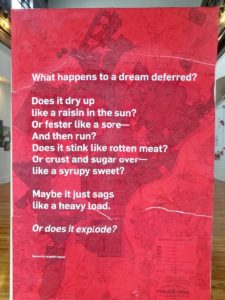‘A Dream Deferred’ exhibit wants to inspire visitors to ‘engage the systems that are doing you wrong’
 October 31, 2018
Category: Feature, Featured, Long, Purpose
October 31, 2018
Category: Feature, Featured, Long, Purpose
In a documentary playing during exhibit hours of Little Giant Creative’s “A Dream Deferred: Redlining Past, Present, Future,” a Philadelphian finds success as an artist outside of his home city and returns years later to find the area where he grew up — Kensington — renovated and resource-filled.
In other words, gentrified.
To his surprise, the people he once knew had been displaced from the area. Reflecting on his visit, he says he would prefer to combine the new resources with the ones he remembers in his formerly Hispanic community.
Documentary. Art installation. Reflection booth. Touch technology. These are all components of the creative agency’s exhibit at 600 Spring Garden, on display through Nov. 17, which explores Philadelphia’s history of redlining, a discriminatory real estate practice. From the “A Dream Deferred” website:
“The redlining practice got its name because of the actual red lines that were drawn on maps by bank lenders, insurers, and government agencies to identify and differentiate neighborhoods during city planning. Redlined neighborhoods are areas where housing prices are manipulated, lenders refuse to offer loans to residents, or sometimes make loans on unfavorable terms in what’s called ‘predatory lending.’
People of color are often targets of redlining. This discriminatory practice creates devastating cycles of poverty that can last within families for generations, and are difficult to escape.”
The majority of American neighborhoods that were redlined 80 years ago are still feeling negative effects from the practice today. And despite being illegal now, the discriminatory practice seems to continuing: The Center for Investigative Reporting’s Reveal found earlier this year that Black Philadelphians were 2.7 times more likely to be denied these loans than their white counterparts.
The Knight Cities Challenge-funded exhibit, named for the poem “Harlem” by Langston Hughes, includes multimedia aspects designed for active learning.
“If you go into an exhibit space or a space that’s giving information, wouldn’t it be great to be able to have it immerse your senses so that you can hear it, you can see it, you can feel it?” said Little Giant cofounder Meegan Denenberg.
Each interactive media type aims to help the community “unpack” their history, she said; welcoming the public to enter is equally as important as giving the public time to digest the information at their own pace, and via different forms. For instance, Azavea-made touch screens displaying GIS mapping illustrate ethnic, social and economic trends in Philadelphia over a few decades.
Denenberg said it’s essential for communities to be vigilant about how policy makers are moving resources, and to know if the resources being developed are “for the people currently living there or the people they hope to attract to that place,” she said.
“The architects for ideas for people who are under-resourced usually come from people who don’t have the cultural competency of understanding what it’s like to live in poverty,” said Little Giant cofounder Tayyib Smith.
(He discussed similar themes at a 2016 Urban Consulate panel: People of color, he said at the time, have notably been promised opportunities that have resulted in displacement, including policies such as the G.I. Bill and the Highway Act.)
Smith said his “relationship with displacement is intergenerational,” and that part of his exposure came in the form of “family folklore,” the life lessons he received from his elders.
“You need to be able to tell a story in a way that’s going to touch people not just intellectually, but emotionally to get them to see this history on some level of humanity,” he said.
Overall, the exhibit aims to inspire visitors to get involved in shaping the policies that affect their lives.
“Being disengaged in the political process, from history, from public policy has never been in our collective best interest,” Smith said. “The only way to make change is to engage the systems that are doing you wrong.”
Project
Knight Cities ChallengeTrending News










